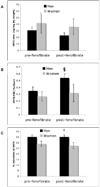Fenofibrate administration does not affect muscle triglyceride concentration or insulin sensitivity in humans
- PMID: 21306746
- PMCID: PMC3135750
- DOI: 10.1016/j.metabol.2010.12.003
Fenofibrate administration does not affect muscle triglyceride concentration or insulin sensitivity in humans
Abstract
Animal data suggest that males, in particular, rely on peroxisome proliferator activated receptor-α activity to maintain normal muscle triglyceride metabolism. We sought to examine whether this was also true in men vs women and its relationship to insulin sensitivity (Si). Normolipidemic obese men (n = 9) and women (n = 9) underwent an assessment of Si (intravenous glucose tolerance test) and intramuscular triglyceride (IMTG) metabolism (gas chromatography/mass spectrometry and gas chromatography-combustion isotope ratio mass spectrometry from plasma and muscle biopsies taken after infusion of [U-(13)C]palmitate) before and after 12 weeks of fenofibrate treatment. Women were more insulin sensitive (Si: 5.2 ± 0.7 vs 2.4 ± 0.4 ×10(-4)/ μU/mL, W vs M, P < .01) at baseline despite similar IMTG concentration (41.9 ± 15.5 vs 30.8 ± 5.1 μg/mg dry weight, W vs M, P = .43) and IMTG fractional synthesis rate (FSR) (0.27%/h ± 0.07%/h vs 0.35%/h ± 0.06%/h, W vs M, P = .41) as men. Fenofibrate enhanced FSR in men (0.35 ± 0.06 to 0.54 ± 0.06, P = .05), with no such change seen in women (0.27 ± 0.07 to 0.32 ± 0.13, P = .73) and no change in IMTG concentration in either group (23.0 ± 3.9 in M, P = .26 vs baseline; 36.3 ± 12.0 in W, P = .79 vs baseline). Insulin sensitivity was unaffected by fenofibrate (P ≥ .68). Lower percentage saturation of IMTG in women vs men before (29.1% ± 2.3% vs 35.2% ± 1.7%, P = .06) and after (27.3% ± 2.8% vs 35.1% ± 1.9%, P = .04) fenofibrate most closely related to their greater Si (R(2) = 0.34, P = .10) and was largely unchanged by the drug. Peroxisome proliferator activated receptor-α agonist therapy had little effect on IMTG metabolism in men or women. Intramuscular triglyceride saturation, rather than IMTG concentration or FSR, most closely (but not significantly) related to Si and was unchanged by fenofibrate administration.
Copyright © 2011 Elsevier Inc. All rights reserved.
Conflict of interest statement
Figures


Similar articles
-
Altered intramuscular lipid metabolism relates to diminished insulin action in men, but not women, in progression to diabetes.Obesity (Silver Spring). 2010 Nov;18(11):2093-100. doi: 10.1038/oby.2010.76. Epub 2010 Apr 8. Obesity (Silver Spring). 2010. PMID: 20379150 Free PMC article.
-
Inflexibility in intramuscular triglyceride fractional synthesis distinguishes prediabetes from obesity in humans.Obesity (Silver Spring). 2010 Aug;18(8):1524-31. doi: 10.1038/oby.2009.454. Epub 2009 Dec 24. Obesity (Silver Spring). 2010. PMID: 20035285 Free PMC article.
-
Intramuscular lipid metabolism in the insulin resistance of smoking.Diabetes. 2009 Oct;58(10):2220-7. doi: 10.2337/db09-0481. Epub 2009 Jul 6. Diabetes. 2009. PMID: 19581421 Free PMC article.
-
High intramuscular triglyceride turnover rates and the link to insulin sensitivity: influence of obesity, type 2 diabetes and physical activity.Appl Physiol Nutr Metab. 2022 Apr;47(4):343-356. doi: 10.1139/apnm-2021-0631. Epub 2022 Jan 21. Appl Physiol Nutr Metab. 2022. PMID: 35061523 Review.
-
Increased intramuscular lipid storage in the insulin-resistant and endurance-trained state.Pflugers Arch. 2006 Feb;451(5):606-16. doi: 10.1007/s00424-005-1509-0. Epub 2005 Sep 10. Pflugers Arch. 2006. PMID: 16155759 Review.
Cited by
-
Novel therapies with precision mechanisms for type 2 diabetes mellitus.Nat Rev Endocrinol. 2021 Jun;17(6):364-377. doi: 10.1038/s41574-021-00489-y. Epub 2021 May 4. Nat Rev Endocrinol. 2021. PMID: 33948015 Review.
-
Modulation Effect of Peroxisome Proliferator-Activated Receptor Agonists on Lipid Droplet Proteins in Liver.J Diabetes Res. 2016;2016:8315454. doi: 10.1155/2016/8315454. Epub 2015 Dec 7. J Diabetes Res. 2016. PMID: 26770990 Free PMC article.
-
Pemafibrate, a New Selective PPARα Modulator: Drug Concept and Its Clinical Applications for Dyslipidemia and Metabolic Diseases.Curr Atheroscler Rep. 2020 Jan 23;22(1):5. doi: 10.1007/s11883-020-0823-5. Curr Atheroscler Rep. 2020. PMID: 31974794 Free PMC article. Review.
-
Novel Selective PPARα Modulator Pemafibrate for Dyslipidemia, Nonalcoholic Fatty Liver Disease (NAFLD), and Atherosclerosis.Metabolites. 2023 May 2;13(5):626. doi: 10.3390/metabo13050626. Metabolites. 2023. PMID: 37233667 Free PMC article. Review.
-
Cardiometabolic impact of non-statin lipid lowering therapies.Curr Atheroscler Rep. 2014 Feb;16(2):390. doi: 10.1007/s11883-013-0390-0. Curr Atheroscler Rep. 2014. PMID: 24395391 Review.
References
-
- DeFronzo RA, Ferrannini E, Hendler R, Felig P, Wahren J. Regulation of splanchnic and peripheral glucose uptake by insulin and hyperglycemia in man. Diabetes. 1983;32:35–45. - PubMed
-
- Baron AD, Brechtel G, Wallace P, Edelman SV. Rates and tissue sites of non-insulin- and insulin-mediated glucose uptake in humans. Am J Physiol. 1988;255:E769–E774. - PubMed
-
- Goodpaster BH, Theriault R, Watkins SC, Kelley DE. Intramuscular lipid content is increased in obesity and decreased by weight loss. Metabolism. 2000;49:467–472. - PubMed
-
- Krssak M, Falk Petersen K, Dresner A, et al. Intramyocellular lipid concentrations are correlated with insulin sensitivity in humans: a 1H NMR spectroscopy study. Diabetologia. 1999;42:113–116. - PubMed
-
- Pan DA, Lillioja S, Kriketos AD, et al. Skeletal muscle triglyceride levels are inversely related to insulin action. Diabetes. 1997;46:983–988. - PubMed
Publication types
MeSH terms
Substances
Grants and funding
LinkOut - more resources
Full Text Sources
Medical

